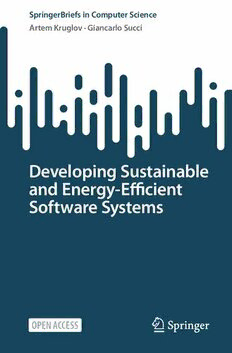
Developing Sustainable and Energy-Efficient Software Systems PDF
Preview Developing Sustainable and Energy-Efficient Software Systems
SpringerBriefs in Computer Science Artem Kruglov · Giancarlo Succi Developing Sustainable and Energy-Efficient Software Systems SpringerBriefs in Computer Science SeriesEditors StanZdonik,BrownUniversity,Providence,RI,USA ShashiShekhar,UniversityofMinnesota,Minneapolis,MN,USA XindongWu,UniversityofVermont,Burlington,VT,USA LakhmiC.Jain,UniversityofSouthAustralia,Adelaide,SA,Australia DavidPadua,UniversityofIllinoisUrbana-Champaign,Urbana,IL,USA XueminShermanShen,UniversityofWaterloo,Waterloo,ON,Canada BorkoFurht,FloridaAtlanticUniversity,BocaRaton,FL,USA V.S.Subrahmanian,UniversityofMaryland,CollegePark,MD,USA MartialHebert,CarnegieMellonUniversity,Pittsburgh,PA,USA KatsushiIkeuchi,UniversityofTokyo,Tokyo,Japan BrunoSiciliano,UniversitàdiNapoliFedericoII,Napoli,Italy SushilJajodia,GeorgeMasonUniversity,Fairfax,VA,USA NewtonLee,InstituteforEducation,ResearchandScholarships,LosAngeles,CA, USA SpringerBriefs present concise summaries of cutting-edge research and practical applicationsacrossawidespectrumoffields.Featuringcompactvolumesof50to 125pages,theseriescoversarangeofcontentfromprofessionaltoacademic. Typicaltopicsmightinclude: (cid:129) Atimelyreportofstate-of-theartanalyticaltechniques (cid:129) A bridge between new research results, as published in journal articles, and a contextualliteraturereview (cid:129) Asnapshotofahotoremergingtopic (cid:129) Anin-depthcasestudyorclinicalexample (cid:129) A presentationofcoreconceptsthatstudentsmustunderstandinordertomake independentcontributions Briefsallowauthorstopresenttheirideasandreaderstoabsorbthemwithminimal time investment. Briefs will be published as part of Springer’s eBook collection, withmillionsofusersworldwide.Inaddition,Briefswillbeavailableforindividual print and electronic purchase. Briefs are characterized by fast, global electronic dissemination, standard publishing contracts, easy-to-use manuscript preparation and formatting guidelines, and expedited production schedules. We aim for pub- lication 8–12 weeks after acceptance. Both solicited and unsolicited manuscripts areconsideredforpublicationinthisseries. **Indexing:ThisseriesisindexedinScopus,Ei-Compendex,andzbMATH** Artem Kruglov (cid:129) Giancarlo Succi Developing Sustainable and Energy-Efficient Software Systems ArtemKruglov GiancarloSucci InnopolisUniversity UniversitàdiBologna Innopolis,Russia Bologna,Italy ThisworkwassupportedbyInnopolisUniversityandtheRussianScienceFoundation(Grant No.19-19-00623) ISSN2191-5768 ISSN2191-5776 (electronic) SpringerBriefsinComputerScience ISBN978-3-031-11657-5 ISBN978-3-031-11658-2 (eBook) https://doi.org/10.1007/978-3-031-11658-2 ©TheAuthor(s)2023 Open Access This bookis licensed under the terms of the Creative Commons Attribution 4.0Inter- nationalLicense(http://creativecommons.org/licenses/by/4.0/), whichpermitsuse,sharing,adaptation, distribution andreproduction inanymediumorformat,aslong asyougive appropriate credit tothe originalauthor(s)andthesource,providealinktotheCreativeCommonslicenseandindicateifchanges weremade. Theimages or other third party material in this book are included in the book’s Creative Commons license,unlessindicatedotherwiseinacreditlinetothematerial.Ifmaterialisnotincludedinthebook’s CreativeCommonslicenseandyourintendeduseisnotpermittedbystatutoryregulationorexceedsthe permitteduse,youwillneedtoobtainpermissiondirectlyfromthecopyrightholder. Theuseofgeneraldescriptivenames,registerednames,trademarks,servicemarks,etc.inthispublication doesnotimply,evenintheabsenceofaspecificstatement,thatsuchnamesareexemptfromtherelevant protectivelawsandregulationsandthereforefreeforgeneraluse. Thepublisher,theauthors,andtheeditorsaresafetoassumethattheadviceandinformationinthisbook arebelievedtobetrueandaccurateatthedateofpublication.Neitherthepublishernortheauthorsor theeditorsgiveawarranty,expressedorimplied,withrespecttothematerialcontainedhereinorforany errorsoromissionsthatmayhavebeenmade.Thepublisherremainsneutralwithregardtojurisdictional claimsinpublishedmapsandinstitutionalaffiliations. ThisSpringerimprintispublishedbytheregisteredcompanySpringerNatureSwitzerlandAG Theregisteredcompanyaddressis:Gewerbestrasse11,6330Cham,Switzerland Anna, Hocopustibidedico. Amorest vitaeessentia. Giancarlo Preface Animportantresearchpriorityforthestudyofsustainablesystemsisthedevelop- mentofmodelinganddecision-makingapproachesthatsupportdynamic,adaptive managementratherthanstaticoptimization.Thisrequiresmethodsforunderstand- ing the full implications of alternative choices and their relative attractiveness in terms of enhancing system resilience. Due to the complexity of coupled systems, researchers should explore the simultaneous use of multiple models that reflect differentsysteminterpretationsorstakeholderperspectives.Inthesecircumstances, itisessentialtoanalyze,monitor,andforecastthevaluesofthebasicparametersof thesystem,whichdirectlyaffectitsefficiencyandsustainability. A number of technical advances will likely improve the usefulness of models, including rigorous methodologies for dealing with missing and uncertain infor- mation; improved methods for interpretation of multivariate data sets and for multiobjective decision-making involving trade-offs among conflicting goals; and novel modeling methods as alternatives to traditional mathematical models, for example, agent-based models with appropriate utility functions. More generally, thereis agreatneedto identifyandanalyzethe metricsasthemainparametersof sustainabilityofthesystemanditseffectiveness.Softwaremetricsarequantitative measuresofspecificattributesofsoftwaredevelopment,includingsoftwareprocess andproduct.Thereareseveralkindsofmetrics,basedontheanalysisofsourcecode, developedduringthe past few decadesfordifferentprogrammingparadigmssuch asstructuredprogrammingandobject-orientedprogramming(OOP).Animportant stepinestablishingameasurementprogramistheselectionofthemeasurestouse. The selection of the metrics should fit the process used and should have a direct impactonthequalityofthedeliveredsoftware.Differentmetricsmaybeappropriate for different products or processes even within the same organization. Metrics validationisanotherimportanttopicintheareaofsoftwaremeasuresbecausetheir acceptancedependsonwhethertheyareabletopredictimportantqualities. Theobjectivesofthisbookare: (cid:129) To identify existing and easily collectible measures, if possible in the early phasesofsoftwaredevelopment,forpredictingandmodelingboththetraditional vii viii Preface attributesofsoftwaresystemsandattributesspecificallyrelatedtotheirefficient useofresources,andtocreatenewmetricsforsuchpurposes. (cid:129) To describe ways to collect these measures during the entire life cycle of a system, using minimally invasive monitoring of design-time processes, and consolidatethemintoconceptualframeworkstosupportmodelbuildingbyusing a variety of approaches, including statistics, data mining, and computational intelligence. (cid:129) Topresentmodelsandtoolstosupportdesign-timeevolutionofsystemsbasedon design-timemeasuresandtoempiricallyvalidatethem.Themodelswillsupport designers by providing suggestions with the idea of realizing an experience factory based on the analysisof the available measures(e.g., by using a model that identifies a vulnerability in the source code and suggests the need for refactoring). The book is printed by the decision of the Academic Council of Innopolis University. We thank Innopolis University and the Russian Science Foundation (GrantNo.19-19-00623)forsupportingusandallthefellowprofessorsandstudents whilewritingthisbook. Innopolis,Russia ArtemKruglov May2022 GiancarloSucci Contents 1 ConceptandPrinciplesofMeasurement................................... 1 1.1 Definitions ............................................................... 1 1.2 MeaningandAdvantages ............................................... 2 1.3 RepresentationCondition ............................................... 5 1.4 MeasurementCharacteristics ........................................... 5 1.5 KindsofMetrics ......................................................... 6 1.6 MeasurementScales ..................................................... 7 1.7 SoftwareMetrics ........................................................ 8 1.7.1 LinesofCode(LOC) ........................................... 9 1.7.2 CyclomaticComplexity ......................................... 9 1.7.3 FanInandFanOut .............................................. 11 1.7.4 MaintainabilityIndex(MI) ..................................... 12 1.7.5 QualityMetrics .................................................. 13 1.8 RationaleforNoninvasiveMeasurement ............................... 16 1.9 Conclusion ............................................................... 16 2 MetricsofSustainabilityandEnergyEfficiencyofSoftware ProductsandProcess......................................................... 19 Co-authoredbyZamiraKholmatova 2.1 Early-PhaseMetrics ..................................................... 20 2.2 Late-PhaseMetrics ...................................................... 22 2.3 MetricsofEnergyConsumption ........................................ 25 2.4 Conclusion ............................................................... 26 3 SystemEnergyConsumptionMeasurement............................... 27 Co-authoredbyGcinizweDlamini 3.1 Introduction .............................................................. 27 3.2 EnergyMeasurementsMethods ........................................ 28 3.2.1 HardwareTools ................................................. 29 3.2.2 SoftwareTools .................................................. 31 3.2.3 HybridTools .................................................... 33 ix x Contents 3.3 TheChallengesofEstimatingtheConsumedEnergyin SoftwareDevelopment .................................................. 34 3.4 Machine Learning-Based Approach for Energy ConsumptionMeasurement ............................................. 34 3.4.1 Methodology .................................................... 35 3.4.2 DataCollection .................................................. 35 3.4.3 DataPreprocessing .............................................. 35 3.4.4 MachineLearningModels ...................................... 35 3.4.5 PerformanceEvaluation ........................................ 36 3.4.6 ExperimentalResults ........................................... 37 3.5 Conclusion ............................................................... 37 4 GQMandRecommenderSystemforRelevantMetrics.................. 39 Co-authoredbyAnnaGorb 4.1 Introduction .............................................................. 39 4.2 ConceptofGoal-Question-Metric ...................................... 40 4.3 TheGoal-Question-MetricProcess ..................................... 41 4.4 RecommenderSystems ................................................. 42 4.5 MetricsRecommender .................................................. 43 4.5.1 Dataset ........................................................... 44 4.5.2 Preprocessing .................................................... 44 4.5.3 RecommenderAlgorithm ....................................... 45 4.5.4 Conclusion ...................................................... 46 5 MetricsRepresentationandDashboards................................... 47 Co-authoredbyIdelIshbaev 5.1 LiteratureReview ....................................................... 48 5.1.1 ReviewofLiteratureonDashboards ........................... 48 5.1.2 TypesofDashboards ............................................ 49 5.1.3 Purposes/ObjectivesofDashboards ............................ 50 5.1.4 VisualizationMethodsofDashboards ......................... 51 5.2 MethodologyandImplementation...................................... 52 5.2.1 InnometricsProject ............................................. 52 5.2.2 VisualizationforDevelopers ................................... 55 5.2.3 VisualizationforManagers ..................................... 55 5.2.4 CommonVisualandFunctionalFeatures ...................... 56 5.2.5 Architecture,Implementation .................................. 56 5.2.6 Conclusion ...................................................... 58 6 ArchitectureofAISEMASystem ........................................... 61 Co-authoredbyXavierVasquez 6.1 DataCollectors .......................................................... 62 6.1.1 QualityAttributes ............................................... 62 6.1.2 Features .......................................................... 62 6.1.3 InternalDesign .................................................. 63
